
Guests
- Jeremy Scahillsenior reporter at The Intercept.
- Ryan GrimWashington, D.C., bureau chief for The Intercept.
We speak with Jeremy Scahill and Ryan Grim of The Intercept about their exposé of a major New York Times piece into alleged mass rapes committed by Hamas militants on October 7 that raises serious questions about the accuracy of the story. The Times article was headlined “'Screams Without Words': How Hamas Weaponized Sexual Violence on Oct. 7,” and its release in late December helped the Israeli government to justify the ongoing war on Gaza and to paint pro-Palestine supporters abroad as not caring about sexual violence. One of the reporters of the Times piece, Israeli freelancer Anat Schwartz, is being investigated by the Times for her social media activity, which included dehumanizing language and endorsements of violence against Palestinians in Gaza. ”The New York Times has grave, grave mischaracterizations, sins of omission, reliance on people who have no forensic or criminology credentials to be asserting that there was a systematic rape campaign put in place here,” says Scahill, who criticizes the newspaper for not issuing any corrections for their flawed reporting. We also hear from Ryan Grim about how the flawed Times article touched off “extremely intense debate” inside the newsroom. “They’re used to external criticism, but the amount of internal criticism they’re getting has them on the back foot,” he says.
Transcript
AMY GOODMAN: This is Democracy Now!, democracynow.org, The War and Peace Report. I’m Amy Goodman.
The New York Times is reportedly conducting an internal investigation to identify the source behind leaked information about its coverage of Israel and Gaza. According to Vanity Fair, the internal investigation follows a report in The Intercept about the Times shelving an episode of its podcast The Daily over doubts regarding the accuracy of a highly controversial blockbuster New York Times article published at the end of December alleging Hamas members committed widespread sexual violence, weaponized it, on October 7th. Vanity Fair reports that in recent weeks management of The New York Times have questioned at least two dozen staffers, including producers of The Daily, the podcast, in an attempt to understand how internal details about the podcast’s editorial process got out.
Democracy Now! asked The New York Times about the internal investigation. The paper’s international editor, Phil Pan, said in a statement, quote, “We aren’t going to comment on internal matters. I can tell you that the work of our newsroom requires trust and collaboration, and we expect all of our colleagues to adhere to these values,” end-quote.
The New York Times article at the center of the controversy was published December 28th. It was headlined “'Screams Without Words': How Hamas Weaponized Sexual Violence on Oct. 7.” In it, the Times reported they had found evidence of systematic sexual violence orchestrated by Hamas and that their two-month investigation, quote, “uncovered painful new details, establishing that the attacks against women were not isolated events but part of a broader pattern of gender-based violence on Oct. 7,” unquote.
However, not long after the highly publicized article was published, major discrepancies began to emerge, including public comments from the family of a major subject of the article, contradictory claims from a key witness, and criticisms over a lack of solid evidence in the overall investigation. Then news emerged last week that one of the three authors of The New York Times piece, named Anat Schwartz, had liked multiple posts on social media advocating for violence against Palestinians, including one that called for turning Gaza into a slaughterhouse. Anat Schwartz is an Israeli filmmaker who had no prior reporting experience before she was assigned by the Times to work on the major investigation along with her relative Adam Sella and veteran Times reporter Jeffrey Gettleman.
On Wednesday, The Intercept published another in-depth investigation that further questions the Times article and the reporting process behind it. It’s headlined “'Between the Hammer and the Anvil': The Story Behind the New York Times October 7 Exposé,” and the two Intercept reporters who wrote it join us today. Jeremy Scahill is a senior reporter and correspondent at The Intercept. He’s joining us from Germany. And Ryan Grim is The Intercept’s bureau chief in Washington, D.C., where he joins us from.
We welcome you both to Democracy Now! Jeremy, let’s begin with you. Can you lay out first the significance of the New York Times article that’s at the center of the controversy, and then talk about your latest piece, that looks into how it all came about?
JEREMY SCAHILL: Well, Amy, in early December, you had the death toll skyrocketing in Gaza. You had a number of nations, including those that are allies with Israel, starting to speak out about the death toll among women, children, the elderly. And part of a pattern of what we’ve seen throughout the course of these five months of scorched-earth attacks against Gaza is that whenever Israel perceives itself to be losing the narrative war or when it needs to remind the public of its perception that Israel is the only victim in this story, they unload a new round of attacks against a variety of individuals or organizations that are working in Gaza or living in Gaza, human beings. We saw that with the attacks against UNRWA. We saw that with the attacks against Al-Shifa and other hospitals.
And in early December, Prime Minister Benjamin Netanyahu and his government really began an intense propaganda campaign to convince the world that Hamas had engaged in a systematic campaign of rape aimed at Jewish women and girls. And then they launched this fake criticism of feminist organizations, saying that they had all systematically failed to stand up and denounce this systematic rape regime that had been intentionally implemented by Hamas in the October 7th attacks. And on the day that Netanyahu made his most prominent statement about this, President Biden was at a fundraising event in Boston, and he issued — he made a statement at his speech that echoed what Netanyahu said, and said the world, you know, can’t turn away and ignore this.
Well, what was happening at that very moment was that The New York Times, with one of its most prominent international correspondents, Jeffrey Gettleman, he had recently hit the ground in Israel, and he was working — Gettleman enlisted the help of two individuals that were going to work with him there. And Gettleman had proposed three lines of investigation, and one of them was the issue of sexual violence. And the two individuals that Gettleman was working with, one of them is a very young person who’s only recently gotten into journalism, Adam Sella, and he had mostly been like a food journalist and has a background in looking at agricultural issues, etc. He had started to write some freelance pieces that were dipping into the waters of politics and the conflict, but a quite inexperienced reporter. And then, the other was someone with no reporting experience outside of making some documentary films, and that is Anat Schwartz. It’s unclear how Anat Schwartz, in particular, got involved with this project.
And as you mentioned, she had, early on in the Israeli attacks against Gaza, liked a tweet that actually was cited by the International Court of Justice as a potentially — a statement of potential genocidal incitement. She also liked the tweet from the Israeli government promoting the debunked allegation that 40 babies had been beheaded on October 7th, which is entirely false, as well as another tweet that said, “We must just refer to Hamas as ISIS.”
And so, they start off on this investigation, and our understanding from sources is that the overwhelming majority of the interviews and reporting that was being done on the ground was being handled by Anat Schwartz and Adam Sella.
And we discovered a podcast interview with Anat Schwartz in Hebrew that she gave, where she — it’s a shocking podcast in how much detail she offers about the process that they used when they were reporting it. And just to put it in a nutshell, she describes how the first thing that she did was start to call around to what she describes as all of the Israeli hospitals that have facilities that are called Room 4 facilities. These would be the intake places where people who have been victims of sexual crimes, including assault and rape, etc., where they would be examined or their cases would be referred. And she said that not a single one of them reported that they had any reports of sexual assault or rape on October 7th.
She then started calling around to a rape crisis hotline and describes how she had this, what she described as an intense conversation with the manager of the rape crisis hotline in that part of Israel, where she was dumbfounded when he was saying he didn’t have any calls reporting sexual assault or rape. And she’s saying, “How is this possible?”
And then she starts talking — she goes to a holistic therapeutic center that was established at a former high-end retreat center outside of Tel Aviv, where mostly people from the Nova rave, where there were attacks and where a couple of hundred people were killed — it was a place where people could do alternative medicine and yoga, relaxation therapy — I mean, people who were highly traumatized. And she goes there, and her characterization was that she sensed what she called a “conspiracy of silence” among the therapists, because none of them were telling her, “Yes, we’re treating people who were raped or had experienced sexual assault.”
And so, when she went through all the official channels, the places where you would reach out to see, if you’re exploring if there’s a pattern here, what then happened is she starts to look at who’s been interviewed about alleged rapes during the October 7th attacks, and ends up then going and reinterviewing a handful of people who already had made assertions that they witnessed rapes. And some of these people had told varying versions of their stories — which in and of itself does not necessarily mean that they didn’t witness something. I mean, these are people that were in the midst of an incredibly violent episode. But more central to that is that some of the people that The New York Times relied on to assert that there was a systematic, intentional campaign of rape weaponized by Hamas were people that have no forensic credentials, no crime scene credentials. These were people that are not legally permitted in Israel to determine rape, that they relied on these individuals to make this claim that there was a systematic rape regime implemented.
And some of those people, Amy, have well-documented track records of promoting very incendiary narratives about atrocities that occurred on October 7th that were flagrantly false. Just two examples. One of the most prominent or ubiquitous figures that has emerged in Israel’s narrative that Hamas committed systematic rape is an architect from New Jersey named Shari Mendes, who is living in Israel now and is a member of the Israeli Defense Forces rabbinical unit. And she was deployed to prepare women’s bodies for burial in the bases where Hamas attacked military facilities. And she’s been quoted widely saying that they saw widespread evidence of rape and that she personally saw it. She described broken pelvises, not just among, you know, soldiers, but among grandmothers and children. But Shari Mendes also was quoted by the Daily Mail as saying that a pregnant woman had a fetus cut out of her body and that the fetus was beheaded and then the mother was beheaded. This is entirely false. We’ve gone through all of the official records that Israel has put out on people who died that day. There was no pregnant woman killed that day. That’s been thoroughly debunked. She also relied on Yossi Landau, a senior official at Zaka. Zaka has been — it’s an ultra-Orthodox private rescue organization. It’s been exposed by Haaretz, the newspaper in Israel, as one of the leading promoters of false information and also that they contaminated the crime scenes by moving evidence around that actual professionals could have done. They also had promoted the beheaded babies stories, etc.
So, The New York Times, they can’t find anyone who works in the rape crisis centers, at the hospitals, among therapists, that are coming forward and saying, “Yeah, we saw this,” or “We have documentation of this,” so they go to people who already were known to have promoted false information, and then they start relying on their testimony to paint this tapestry, this notion that there was a systematic rape regime. And in the New York Times article, they do not ever disclose that their key witnesses have serious credibility problems. So, this is, at a minimum, we are looking at a New York Times piece that failed to inform its readers about severe credibility issues among some of its premier “witnesses,” quote-unquote, that it put forward in this story.
AMY GOODMAN: I wanted to go to part of a podcast interview that Anat Schwartz did on January 3rd, produced by Israel’s Channel 12. It was conducted in Hebrew. Here, Anat talks about the difficulties and pressures in reporting the story.
ANAT SCHWARTZ: [translated] Maybe the standard that we have to meet may not be realistic. Maybe it won’t be this complete big story that is told from beginning to end and is complex and has details and nuances and characters. And maybe we are aiming too high. Then there was the U.N. woman and the silence, and there was a lot of preoccupation with it. So, I said, “We’re missing momentum.” Maybe the U.N. isn’t addressing sexual assault because no outlet will come out with a declaration about what happened there, and that it will no longer be interesting. And at some point, after one of the rewrites, we said, “OK, that’s it.” And then I already informed all the people in the Israeli police who are waiting to see what was going on. What? Was The New York Times not believing there were sexual assaults here? And I’m also in this place. I’m also an Israeli, but I also work for The New York Times. So, all the time, I’m like in this place between the hammer and the anvil.
AMY GOODMAN: That’s Anat Schwartz, speaking on a podcast on January 3rd. She said she felt “between the hammer and the anvil,” which, Jeremy, you choose as the title of your piece. Talk about the significance of that and, again, the relationship between Anat Schwartz and other reporter, the young reporter, Adam Sella.
JEREMY SCAHILL: Well, another part of this story is that one of the main victims that was featured in this is referred to as “the woman in the black dress.” Gal Abdush is her name. And, in fact, her family members are the individuals in the feature photo on the piece. And another thing that we’ve learned from Israeli researchers who published this is that when Anat Schwartz and Adam Sella went to a woman that had taken photographs of Gal Abdush that day, they told this photographer that it was her duty under Israeli hasbara to cooperate with The New York Times and let them have all of her photos. And ”hasbara” is the term for public diplomacy, but what it really is is the notion that Israel should engage in externally focused propaganda in order to win over international audiences, primarily Western, the United States and powerful countries, to Israel’s point of view. So, she is using this term, going and trying to encourage someone to cooperate with The New York Times, not because The New York Times is, you know, the most important news organization in the world, but because it’s their duty under Israeli hasbara. So, when she talks about being caught between the hammer and the anvil, what she’s saying is she’s caught between her duty to be honest and a journalist and her duty to serve the agenda of the Israeli state.
And her partner in this, Adam Sella, is the nephew of Anat Schwartz’s partner, and they’re not married. In fact, Amy, The New York Times, they requested a correction from us, because we had initially said that it was her nephew, which I think in the context of America and other countries you would say. If you’re somebody’s longtime life partner, you would say, “Oh, yeah, this is my nephew.” OK, they’re not blood relatives, and they emphasize that she’s not married. Fine, we corrected that.
My question is: Where are the corrections in The New York Times piece? The New York Times has grave, grave mischaracterizations, sins of omission, reliance on people who have no forensic or criminology credentials to be asserting that there was a systematic rape campaign put in place here. And to publish this article at a moment when Israel was intensifying, after that brief pause where captives were exchanged — intensifying its genocidal attack against the people of Gaza, this played a very, very significant role. And the more we learn about this, the more we discover that the reporting tactics that The New York Times used are certainly not up to the standards that the newspaper claims to be promoting. They will not issue any corrections on what has already been documented to be very problematic sins of commission and omission in this piece.
AMY GOODMAN: We’re going to break and then come back to this conversation. We’re talking to Jeremy Scahill, senior reporter at The Intercept. Next up, he’ll be joined by Ryan Grim, who is the Washington bureau chief of The Intercept, and we want to talk to Ryan about what’s happening in The New York Times now in response to this story, and the leak investigation that’s going on, and why a podcast based on their story, their own podcast, The Daily, didn’t air. Stay with us.
[break]
AMY GOODMAN: “I’m from Here” by Amal Markus. This is Democracy Now!, democracynow.org, The War and Peace Report. I’m Amy Goodman.
We’re speaking with Intercept reporters Jeremy Scahill and Ryan Grim about their exposé into The New York Times article that was published at the end of December. They published another one in January.
We asked The New York Times for a response to your article, and the international editor, Phil Pan, responded, quote, “Ms. Schwartz was part of a rigorous reporting and editing process. She made valuable contributions and we saw no evidence of bias in her work. We remain confident in the accuracy of our reporting and stand by the team’s investigation. But as we have said, her 'likes' of offensive and opinionated social media posts, predating her work with us, are unacceptable,” end-quote.
Ryan, if you can respond to this and talk about what’s going on internally in the Times, and also talk about this leak investigation that’s going on within the paper of record?
RYAN GRIM: [inaudible] by her own admission, in that podcast interview she had, significant violence, because there are two ways to think about what happened on October 7th. The first way is that it was a day of extraordinary mayhem and violence. The Israeli defenses melted away. Not only did you have several thousand Hamas fighters stream across the fence, but you also had hundreds of civilians, some associated with gangs, come across. And in that context, the idea that there would be no sexual assault is not taken seriously by pretty much anybody who understands kind of war and violence. That’s one way to think about October 7th.
The other way to think about it is that Hamas intentionally and systematically designed a kind of strategy of weaponizing rape and sexual violence. That was what Anat Schwartz and The New York Times kind of believed going into the investigation. And oftentimes as journalists, we have something that we think we’re going to be able to prove, we report it out, and then we can’t quite get it. Like, it just — we just don’t land the story. But what the Times did is they wrote the story anyway.
But that gets you then to The Daily episode. So, this article comes out at the very end of December. As The New York Times always does, its landmark pieces get turned into episodes of their flagship podcast, The Daily. But immediately after the story came out, it started coming under criticism, because, as Jeremy pointed out, a lot of the named subjects of the story have enormous credibility problems. And so this starts getting pointed out. Inside the Times, the producers of The Daily have their own kind of fact-checking process where they go over the stories. And the original script that was produced for that first episode had to be discarded, because the producers there couldn’t stand behind it, so they redrafted a second script, which had a lot of caveats and was closer to the first version that I laid out just now, which is an interesting podcast episode, and it’s something worth exploring. But if they had aired that, it would have raised questions about why they were walking away from the certainty of the original piece.
So, we reported on the kind of machinations inside The New York Times about this, the controversy, the disputes that were going on. And since then, as Vanity Fair reported, The New York Times has — rather than reviewing the kind of journalism that went into this, they are launching a leak investigation to try to figure out who’s talking to us.
AMY GOODMAN: In February, one of the reporters behind The New York Times investigation, the Pulitzer Prize-winning reporter Jeffrey Gettleman, spoke at a conference on conflict-related sexual violence hosted by Columbia University. He talked about the piece.
JEFFREY GETTLEMAN: I did some stories about hostages. And pretty soon, I mean, maybe, I don’t know, within the first few days of this attack, we were hearing reports of rape and mutilations of women. We heard it right away. And I don’t — maybe people in this room remember those videos of the female soldiers being taken away and the body of that one woman, Shani Louk, in the back of a pickup truck half-naked. Right away, it just — it just — there was obviously crimes against women that happened.
So, because, sadly, I have some experience doing this, I began looking to see what we could find out. And I worked with two other colleagues, and we interviewed almost 200 people over the course of two months. And what we found, I don’t want to even use the word “evidence,” because evidence is almost like a legal term that suggests you’re trying to prove an allegation or prove a case in court. That’s not my role. We all have our roles, and my role is to document.
AMY GOODMAN: So, I wanted to get a response to what he is saying there. He’s talking, by the way, to Sheryl Sandberg, the former COO of Meta, Facebook. Jeremy Scahill, if you can talk about what he sees his role as a reporter?
JEREMY SCAHILL: I mean, this is an astonishing comment from Jeffrey Gettleman. I mean, what is he talking about, that it’s not the job of journalists to uncover evidence? If you’re going to have a headline that — by the way, let me just say this. The “Screams Without Words” headline comes from a source named Raz Cohen, who was at the Nova music festival, and he claims to have witnessed a rape of a woman that he said was — and he’s a special forces, Israeli special forces, veteran, and he has been very adamant that the people who he saw committing this crime were not Hamas, that they were ordinary people. And he has said that in numerous interviews. But to have, then — and he’s the one who said it was like “screams without words.” They’re using a headline from a person whose testimony undermines the thesis of their blockbuster story. So, just to put that on the table.
But for Gettleman to say that it’s not the job of journalists to produce evidence, when you’re going to say, in the middle of a war, where civilians are being starved and killed in an operation that is under review now by the International Court of Justice for genocide — if you’re going to then make an allegation that Hamas implemented a systematic rape campaign, and you say it’s not your job to produce evidence, then what is the job of a journalist in a situation like this? Because, honestly, if you really read their piece carefully, much of it is innuendo. Much of it is based on sources who have either credibility issues or lack professional credentials to weigh in on these matters. This is a grave, grave situation. This is one of the most important pieces of journalism that has been produced during this war, and one of the most consequential. And for the lead reporter, who himself has won the Pulitzer and is an experienced war correspondent, to say that it’s not the job of The New York Times to present evidence in an article asserting that Hamas systematically raped women, it’s astonishing. It’s astonishing.
AMY GOODMAN: And also, the prestigious Gorge Polk Award for Foreign Reporting this year was awarded to the staff of The New York Times, the citation reading, in part, quote “for unsurpassed coverage of the war between Israel and Hamas. Times reporters used firsthand accounts to demonstrate how brutal and well planned the Hamas attack was,” end-quote. And this article in question that we’re talking about, “'Screams Without Words,'” was apparently part of the package submitted by The New York Times that won the award. Ryan Grim, if you can talk about that and the dissent within the Times itself?
RYAN GRIM: Before I answer that, I did want to add one thing to what Jeremy was saying. It is remarkable that Sheryl Sandberg was on that panel with Jeffrey Gettleman, because on December 4th — and Jeremy talked about how this campaign was rolled out — on December 4th, Sheryl Sandberg and the Israeli ambassador to the United Nations hosted an event at the U.N. that launched the campaign against these feminist organizations for not standing up and condemning, you know, Hamas’s systematic use of rape. The next day, it was Bibi Netanyahu and then Biden who piled on that campaign. That same day, on December 4th, Sheryl Sandberg penned an op-ed in CNN. She also gave interviews or was quoted in The New York Times on that same day in an article by Jeffrey Gettleman, Anat Schwartz and Adam Sella. So, they were all working together on December 4th to launch this campaign.
The December 4th article in The New York Times had a much softer headline. It said, you know, “What Do We Know About the Use of Sexual Violence” or “About Sexual Violence on October 7th?” And people can go back and read that story. They reported at the time that Israel had enormous amounts of forensic evidence that they were going through that would establish all of the claims that they were making. On December 8th or 9th, they very quietly corrected that story to say, “Correction: Israel does not have forensic evidence to back up these claims. It is relying on eyewitness testimony.” Anat Schwartz had previously reported in the Times that they had, quote, “tens of thousands of eyewitnesses” that they were going to bring forward to make these claims. So, they front-loaded this campaign with these major claims that there was forensic evidence and thousands of witnesses. Then their final article comes out at the end of the month, and, to a casual reader, you would come away from reading it, saying, “Well, they proved it. They made their case. This barbaric terrorist organization did use rape systematically against Israeli women.” And that was used to justify the continuation of the war on Gaza.
But then, as you said, when The Daily tried to look closer at the article, they realized they couldn’t actually stand up the claims that were being made in it. And so, inside the Times, you have this extremely intense debate going on. And I think leaders at the Times have been surprised. They’re used to external criticism, but the amount of internal criticism they’re getting has them on the back foot.
AMY GOODMAN: And finally, Jeremy, we just have 30 seconds, but even the use of the term “terrorist” within The New York Times and the stepping back of one of the leading editorial directors?
JEREMY SCAHILL: Yeah, I mean, there’s a lot of — there’s a lot of concern right now, particularly among reporters who do work on an international level, that there has been a politicization of this war internally within the newsroom that is impacting the coverage. And I think it’s pretty clear. You can see that in some of the journalism. And now The New York Times — The New York Times has —
AMY GOODMAN: Five seconds.
JEREMY SCAHILL: — has ended up walking back the major claim that they made, and now they’re saying hedge words: It may have occurred. That’s one of the most significant things we uncovered here.
AMY GOODMAN: Jeremy Scahill and Ryan Grim, they are the co-authors of the piece, “'Between the Hammer and the Anvil.'”


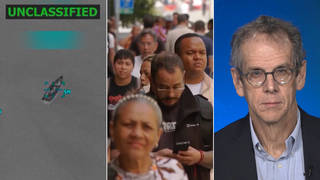
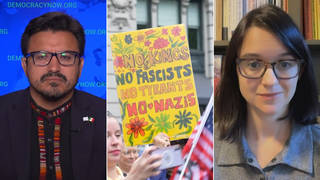
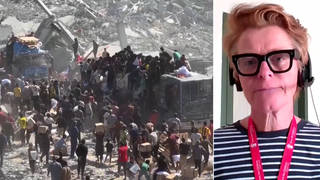





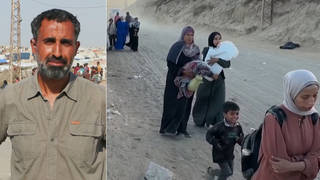
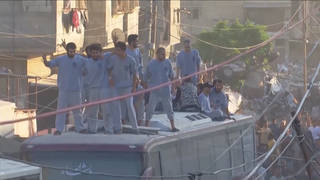
Media Options